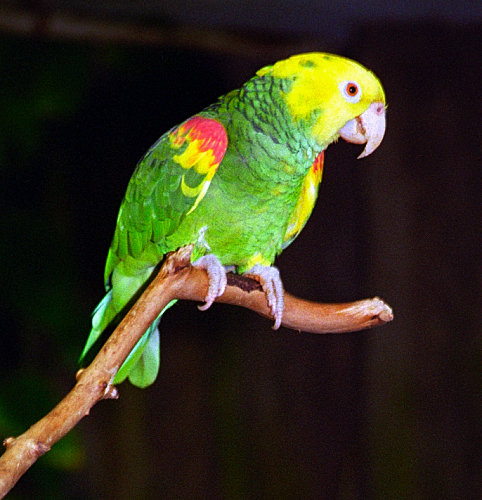
Bird’s the word: the evolution of vocal learning
Yellow-headed Amazon at Vancouver Aquarium, Canada. (Photo by David Ohmer, CC Attribution 2.0 Generic)
If someone calls you a “bird brain,” count yourself praised, not insulted.
Neurobiologist Erich Jarvis can tell you just why this is so.
For instance, why are parrots able to say “Polly want a cracker” with ease? But a supposedly smarter chimp cannot?
“The ability for vocal imitation (in birds), you can’t find in mice or primates,” said Jarvis, a Howard Hughes Medical Institute (HHMI) investigator who has established a research laboratory at Duke University Medical Center to study vocal learning, or sound imitation. “We’re trying to bring it all together to translate findings from these birds, who can imitate, to our own understanding of genetics and neural pathways for speech.”
These findings allow comparisons of bird’s abilities with those of humans and other animals.
Jarvis presented those findings in a lecture titled “Shaking the Bird Family Tree” at the New Horizons in Science briefing during the ScienceWriters2014 conference — a joint meeting of the National Association of Science Writers and the Council for the Advancement of Science Writing — on Sunday, Oct. 19.
Mary Beth Gardiner, editor of the HHMI Bulletin, said that his presentation “snapped (vocal learning in birds) into a whole different perspective” for her and for others.
How do birds learn to vocalize?
Parrots, hummingbirds and songbirds are among the only birds capable of vocal learning. They join humans, bats, elephants, sea lions, whales, dolphins and porpoises as the only animals with this talent. While of course unable to understand language as people do, such animals can memorize long sequences of words. Dogs, for instance, can understand some words spoken by humans when trained, but can only bark to communicate.
Specialized areas in the forebrain give parrots, hummingbirds and songbirds the power to use vocal motor control, which allows them to imitate sound. These areas control cells in the brainstem that manipulate the muscles used to produce sound. Birds that cannot learn vocally lack forebrain structures that include the HVC and RA nuclei, parts of the motor pathway for song, and additional structures called Area X and LMAN, which form the pathway for song learning.
“Brain size doesn’t really matter — the structure matters more,” Jarvis said, adding that there are seven structures in the bird brain that play a role in vocal learning.
Jarvis has conducted the first genome-scale effort to clarify the evolutionary relationships among bird species capable of vocal learning.
Variations in parts of the genome, or birds’ full genetic code, related to the structures help to reveal the species’ “family trees.” In turn, that permits Jarvis and his team to trace origins of the ability to control language over time.
The similarities among neural pathways and specialized forebrain regions in humans and birds are stronger than those among human brains and other primate brains. Although humans are widely known to share a sizable amount of DNA with chimps, Jarvis said, we have more in common with birds than meets the eye.
“We’re actually finding the genes that we think are contributing to that specialized circuitry (in the birds’ forebrain regions),” he said of his research. More details on his findings are set to go public in December.
Birds on Broadway? (They can learn to dance, too)
Beyond vocal learning, birds also have the motor ability to learn to dance, a feat that Jarvis, a former ballet dancer, is starting to explore in his lab.
Such insights over the years have led Jarvis to lobby for improvements in the terminology used in psychology neuroscience to describe brain structures. He has organized meetings since 2000 in which researchers have discussed renaming scientific terms because they were “all wrong,” and “scientifically inaccurate.”
For example, Jarvis took the initiative to change the term neostriatum to nidopallium. The change, he explained, fixes an implication in the old term’s Latinate roots that brains evolve linearly when in fact changes can be much more complicated. “Nido” means “nested,” and “pallium” means “cortex.”
Now that Jarvis has identified the genes and neural pathways a creature used when making vocal sounds, he plans to manipulate them to understand how to enhance or suppress brain circuitry, and therefore motor functions and abilities, in birds. “… to make a songbird a better singer, for example.”
How about that for some food for thought, “bird brain”?